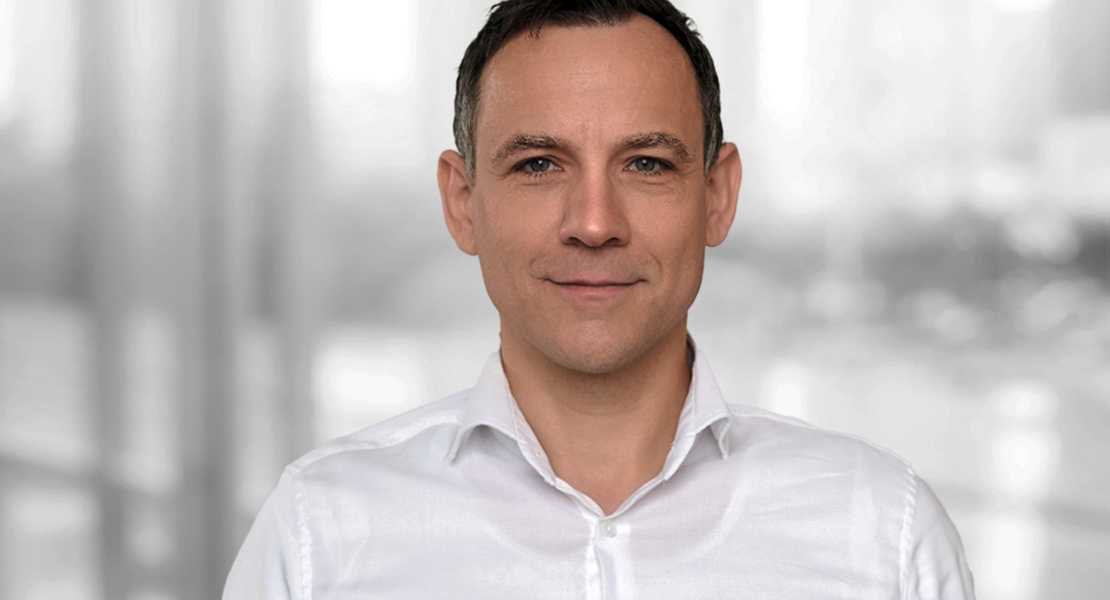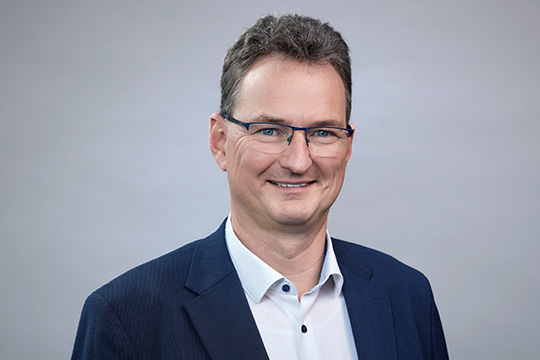Dr. Patrick Hahn is in charge of the division “IT and Digitalization” of Zeiss AG within the scope of the major project “High-Tech Site Jena” (HTSJ). The high-tech center, which has been designated a lighthouse project, is expected to set new standards. In this interview, Dr. Hahn reveals why 5G and campus networks also play an important role in the plans of the global market leader for optics and medical technology products.
The “High-Tech Site Jena” project is expected to enhance significantly the reputation of the entire region. Why will it have this effect?
In conducting this project, we are realizing outstanding standards in architecture, design, and, above all, in innovative working environments. Furthermore, we want to continue development of the site processes for production and logistics and raise them to a new level. Digitalization will be an extremely important enabler in this process.
The construction of the high-tech center for 2,500 employees is intended to underline the importance of Jena as a location, i.e., the place where our company was founded 175 years ago. Zeiss is the largest industrial employer in the region. Located immediately adjacent to the train station and in close proximity to the city center as we are, we want to realize a high degree of mobility and accessibility for all employees. A rigid person-to-workplace relationship will no longer exist. Instead, we want to make it possible for every single employee to work exactly at the best location in view of his or her specific circumstances in the sense of “activity-based working,” whether in the department, in projects, or in collaboration with external partners at the latter’s sites. We are also planning to merge two sites so that all employees benefit from the same options for modern working opportunities.
What is the current status of project progress, and when is it scheduled to go live?
Projects of this magnitude cannot be realized overnight, of course. The construction area has now been cleared, and excavation work is underway. At the moment, the excavation pit is being dug and supported with concrete walls. This slope stabilization is necessary because the pit will have a depth of 20 meters at its deepest point. The construction site is 300 by 200 meters, i.e., the size of several football fields, and more than 100,000 square meters of floor space will be created in the first construction phase. The extensive construction work in combination with modern architecture and new working environments demands diligence and time, so initial occupation is scheduled for 2025.
What scenarios and use cases could possibly be realized at this facility in the future? Can you reveal any examples?
The focus is on new working environments and modern production and logistics processes. The digital concepts include, for example, event-based access control and intelligent control systems that can manage the air conditioning or even cleaning or demand-oriented services in appropriate response to utilization situations. We also want to implement predictive maintenance that will use sensors to estimate when certain control elements are likely to fail and give us an opportunity to take action before the failure actually occurs. This is important because we want to prevent any unforeseen interruptions in our production processes. Another important consideration for us is climate protection; orienting our use of energy to actual demand will be sustainable and cost-efficient.
We also plan to integrate the smartphone into the system as an important building block for certain functions. For example, employees should be able to trigger certain services or tickets and payment transactions as well as obtain the latest information on specific topics. We have yet to define precisely what specific services will be provided because there will be so many further developments over the next few years. I am fairly sure, however, that we will be using driverless transport systems in our logistics operations. We expect this to enable just-in-time supply to our production lines. The buildings that will be constructed must provide sensor data if this is to work as intended. Better integration with ERP and MES systems is also needed. We want to simplify work and production processes to make them more efficient at all times.
What role does a future-oriented campus network play in the construction project and the innovative strength of the site? What technology do you plan to use here?
I mentioned excavation pits with a depth of 20 meters, and any network engineer can tell you that the penetration of radio waves from the outside is absolutely impossible under these circumstances. Instead, we need a campus network that provides telephony services such as 4G and 5G within the building. In addition, the glass surfaces of the buildings will be vaporized with metals to reduce solar radiation, which means that these glass surfaces will also act as shields to radio waves. The construction planning must keep these factors in mind when determining the connection points for the network. We have set dimensions for the server rooms that will accommodate 4G and 5G at a later date. The decisions about the installation work we will actually realize in 2025 and the terminal equipment and RANs (radio access networks) we will use are still pending because the market will continue to develop between now and that date. With respect to the construction, however, we will be able to implement all decisions relatively quickly because we have worked with Detecon to estimate the duration and details of the expenditures in time and costs.
Many manufacturers are still having their difficulties with 5G. Why is Zeiss investing so much in a network expansion even though no application exists on the market (as of now) that mandates a 5G campus network?
It is true that there are not yet many use cases that explicitly require 5G. I am personally convinced, however, that we will be seeing them in the near future. 5G will pave the way to new technologies and applications that require high bandwidth and low latency. It is certainly possible that we will all be surprised at how quickly such use cases develop. Let’s think back to the first iPhone in 2007, a device that offered relatively few functions. A mere three, maybe four years later, the devices were already a key focal point of people’s lives for so many users who could not imagine doing without these mobile phones. Exponential developments are always difficult to predict; nevertheless, we can and must prepare for them. It would be a mistake to wait until the relevant use cases have appeared to begin thinking about 5G. Just retrofitting the building would be substantially more expensive.
What variants of campus networks are available, and why did you choose these specific solutions and operating models? How did Detecon support you in the planning?
We had intensive discussion with Detecon about the opportunities as well as the advantages and disadvantages offered by the various network structures or campus solutions. Essentially, our construction plans have been created to allow all variants. Once the RANs have been physically installed, a large number of variants can be implemented via logical procedures if the corresponding radio frequencies have been registered with the Federal Network Agency. We will make our decisions regarding the variants, installations, or providers when the time is right. But I assume that we will utilize both a public network and private radio spectrum on campus. In other words, we will use the spectrum provided by the provider as well as apply for our own local spectrum for our own use. As we want to benefit from the lowest possible latency and high bandwidths, we will also install a local breakout that will make it possible to process data directly on-site in a local cloud with optimal latency. I am convinced that low latency will be one of the key success criteria for 5G technology. However, I can realize this only if I use my own network structures.
The planning project offered a lot of learning potential on all sides. We started at different cruising altitudes and had to learn to speak a common language before anything else. Telecommunications are not a trivial field; even my colleagues from network architecture have learned a lot, especially since 5G know-how is still anything but widespread in the industry. The learning processes on issues such as network structures, registration processes with the Federal Network Agency, the differences between provider spectrum and public spectrum, or individual RANs — the results enabled us to make qualified decisions at the end of the day.
What recommendations do you have for other companies facing similar network expansion decisions?
If companies are about to embark on construction projects, I unambiguously recommend that they start examining the question of 5G now. Retrofitting a building at a later date when it is already in operation is very costly. If, however, it is a question of retrofitting existing buildings, I would still recommend conducting smaller pilot projects first. Ask yourself where you continue to have problems today or would like to implement use cases — in production, for instance — that you simply cannot realize with today’s wireless technology. 5G may possibly be a replacement for established WLAN/Wi-Fi technologies and provide better wireless coverage.
To what extent will the center also be open to cooperation partners such as municipal or university institutions as a kind of ecosystem? Is its evolution as a smart city planned or conceivable?
Of course external partners should be able to work and develop with us, we will provide them — depending on the use cases — with the same functions that are available to our employees.
The city of Jena is also planning a smart city project parallel to our project. We are in close contact with the city and will certainly create interfaces that will permit the use of services in both directions. Possible interactions may relate to transport and logistics. I cannot yet say precisely what will actually be realized because the projects on both sides are not yet in the realization phase. We are currently defining the architecture and will certainly come up with some ideas later. It goes without saying that the cybersecurity for the entire ecosystem must also be reliably secured beforehand.
Jena has an active digitalization community; several thousand employees are already working in digital companies in the area. There are always plenty of good ideas coming from the combination of the city, start-ups, institutes, digital companies, and other players. The potential is tremendous, and I am confident that we will see a lot of good things happening here.
Thank you for the interview!









